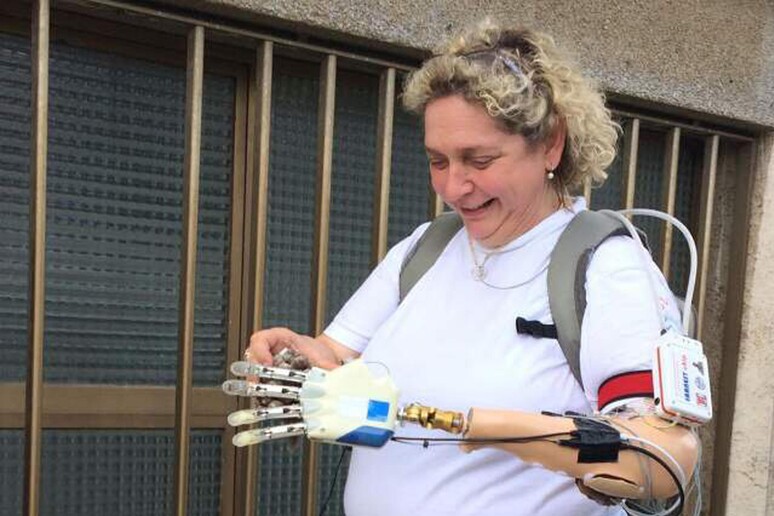A woman has become the first
Italian to have a bionic hand fitted, sources said on Thursday.
The hand, built by Silvestro Micera's team from the Scuola
Superiore Sant'Anna in Pisa and the Polytechnic of Lausanna, was
fitted in June 2016 at Rome's Policlinico Gemelli Hospital by
neurosurgeon Paolo Maria Rossini's team.
The results of trials with the hand are set to be published
in an international scientific journal.
The hand perceives contact with objects.
The hand was fitted in the six-month-long experiment to
Almerina Mascarello, who lives in Veneto and had lost her hand
in an accident.
"The hand is an improved version of the one fitted onto a
Danish man in 2014," Micera told ANSA.
Mascarello is also the first woman who has been able to get
out and about with her hi-tech hand because now, unlike in 2014,
all the necessary electronic equipment has been put into a
backpack.
This, Micera explained, "includes the system that registers
the movement of the muscles and translates them into electrical
signals, which are then turned into a set of commands for the
bionic hand.
"Another system transforms the information registered by the
sensors in the hand in signals to send to nerves and therefore
into sensorial information".
The woman took along the backpack on a foray in Rome in
October 2016, under the watchful eyes of the Italian research
team, Micera said.
The ultimate goal, Micera said, is to make the technology
clinically usable.
The backpack was an intermediate step along the way to this
goal, he said.
"The next step is to miniaturise the electronics," said the
lead researcher.
Micera said the objective of his team was to miniaturise the
electronics "within a few years' time".
He said this technology, with special adjustments, could then
become a "sort of jack-of-all-trades able to be adapted to many
kinds of prostheses, including those of the hands, arms and
legs".
Micera said "we are working towards a completely implantable
and long-term electronic system".
Mascarello, 55, from Montecchio Precalcino near Vicenza in
northern Italy, told ANSA Thursday: "I'm looking forward to May
when the bionic hand made specially for me will arrive.
"Only then will I be able to say that my life has been
completely changed".
Mascarello lost her hand in a work accident in July 1993,
when it was crushed by a press in the industrial factory she was
working in.
She met the Gemelli team by chance.
"I was flicking through a magazine on invalidity when I
noticed a page asking people to undergo a test for a prosthesis.
"The Gemelli doctor phoned me a year later and asked me if I
would like to be a guinea pig for a bionic hand.
"I said I would think about it and I said Yes in May of last
year.
"I went to Rome for the operation in June".
She described using the hand as something "marvelous and
stupendous", recalling that she had been missing a hand for 23
years.
"Now I'm eagerly awaiting them to call me and tell me it's
ready".
Neurologist Paolo Maria Rossini said the hand had been tested
on several people from various countries and that each op had
cost "several thousand euros".
As for the innovative technique used, he said "inserting
electrodes no larger than a human hair enables the motor signals
sent by the brain to be transmitted to the robotic hand which
gets the input and responds.
"Hitherto the stimulator, batteries and instrumentation
linked to the hand have been carried by the patient in a
backpack.
"The next intervention foresees that the whole system,
realised in extremely small dimensions, can be included in the
arm".
Rossini also said a major goal was to "make this technology
cheap to use".
He said "we will start trying to drive costs down as soon as
the next prototypes start coming along".
ALL RIGHTS RESERVED © Copyright ANSA











